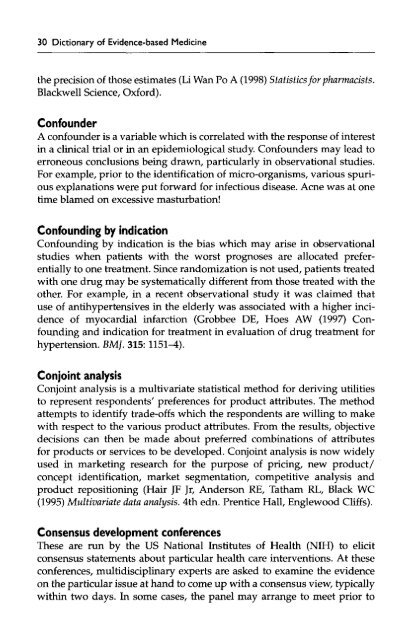Dictionary of Evidence-based Medicine.pdf
Dictionary of Evidence-based Medicine.pdf
Dictionary of Evidence-based Medicine.pdf
Create successful ePaper yourself
Turn your PDF publications into a flip-book with our unique Google optimized e-Paper software.
30 <strong>Dictionary</strong> <strong>of</strong> <strong>Evidence</strong>-<strong>based</strong> <strong>Medicine</strong><br />
the precision <strong>of</strong> those estimates (Li Wan Po A (1998) Statistics for pharmacists.<br />
Blackwell Science, Oxford).<br />
Confounder<br />
A confounder is a variable which is correlated with the response <strong>of</strong> interest<br />
in a clinical trial or in an epidemiological study. Confounders may lead to<br />
erroneous conclusions being drawn, particularly in observational studies.<br />
For example, prior to the identification <strong>of</strong> micro-organisms, various spurious<br />
explanations were put forward for infectious disease. Acne was at one<br />
time blamed on excessive masturbation!<br />
Confounding by indication<br />
Confounding by indication is the bias which may arise in observational<br />
studies when patients with the worst prognoses are allocated preferentially<br />
to one treatment. Since randomization is not used, patients treated<br />
with one drug may be systematically different from those treated with the<br />
other. For example, in a recent observational study it was claimed that<br />
use <strong>of</strong> antihypertensives in the elderly was associated with a higher incidence<br />
<strong>of</strong> myocardial infarction (Grobbee DE, Hoes AW (1997) Confounding<br />
and indication for treatment in evaluation <strong>of</strong> drug treatment for<br />
hypertension. BMJ. 315:<br />
Conjoint analysis<br />
Conjoint analysis is a multivariate statistical method for deriving utilities<br />
to represent respondents' preferences for product attributes. The method<br />
attempts to identify trade-<strong>of</strong>fs which the respondents are willing to make<br />
with respect to the various product attributes. From the results, objective<br />
decisions can then be made about preferred combinations <strong>of</strong> attributes<br />
for products or services to be developed. Conjoint analysis is now widely<br />
used in marketing research for the purpose <strong>of</strong> pricing, new product/<br />
concept identification, market segmentation, competitive analysis and<br />
product repositioning (Hair JF Jr, Anderson RE, Tatham RL, Black WC<br />
(1995) Multivariate data analysis. 4th edn. Prentice Hall, Englewood Cliffs).<br />
Consensus development conferences<br />
These are run by the US National Institutes <strong>of</strong> Health (NIH) to elicit<br />
consensus statements about particular health care interventions. At these<br />
conferences, multidisciplinary experts are asked to examine the evidence<br />
on the particular issue at hand to come up with a consensus view, typically<br />
within two days. In some cases, the panel may arrange to meet prior to










